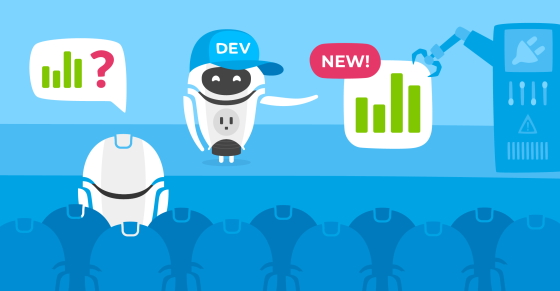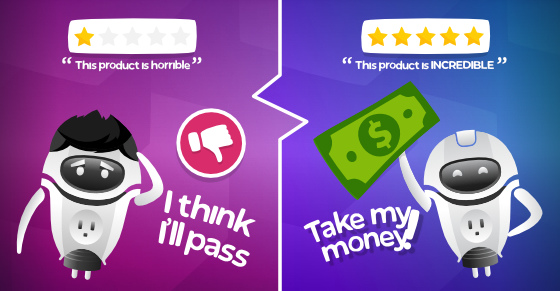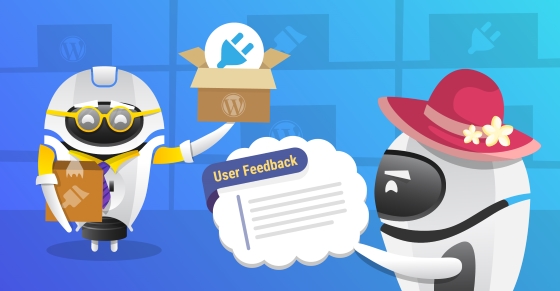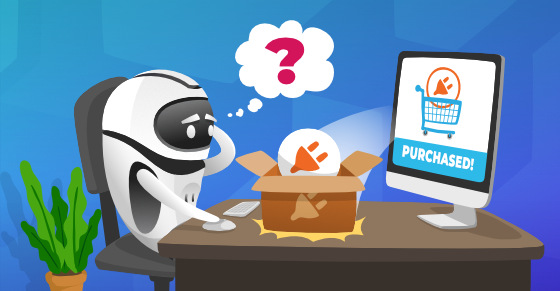Building a WordPress website is all about customization to make it look and act the way a customer wants. So, what does that mean for plugin and theme developers like yourself who get requests for features or customizations of all kinds? Should you accommodate those requests or toss them to the side and focus strictly on your product development goals?
As a plugin developer, it’s inevitable that people will contact you asking for something that your product doesn’t do.
Whether people contact you through support, your website contact form, or submit a feature request through a public board, some requests you get will be worth considering in your product development pipeline.
To leverage each request as much as possible, you should consider three questions:
- Is the request a feature or customization?
- Is the person making the request a free user or paying customer?
- Who is making the request?
The answers to these questions will help you achieve 3 things:
- Determine if it’s in your best interest to meet the request.
- Assess the ROI for developing the requested functionality.
- Formulate an offer that will be appealing to the person.
Let’s go through each of the questions and discuss the best way to leverage the requests you get.
Leveraging Customization Requests
How to identify if an inquiry is a feature request or a customization request?
It’s important to “read between the lines” early on when you get a request from a customer in order to identify if the request is a feature or customization. Many customers might think they’re requesting customization, when, in fact, it’s really a feature (and vice versa).
The difference between them is really important to your business because they each have a different value.
Feature requests include functionality that can be used by many people.
Customization requests include functionality needed by an individual person for a specific purpose.
Customizations are extremely valuable when a person’s individual needs overlap with market needs. At that point, they’re no longer customizations – they’re features!

Features increase your product’s value and have the potential to offer much greater ROI because they’re valuable to more than one person, and so more people will want to buy your product.
Customizations, on the other hand, are mostly valuable to that individual person.
That being said, customization requests can still be valuable to consider because you can often build features out of them. So, keep in mind that you aren’t committing yourself to anything by simply accepting feature or customization requests – how you respond to them is what matters.
If you find that a request is not in your best interest or you don’t want to diverge from your product priorities, you can always respond with something like this:
Thank you very much for the request. I added your request to our TODOs list, but, unfortunately, we don’t have the resources to build it at this point in time.
On the flip side, if you think a request is valuable to your business and something you want to move forward with, consider the second question in order to help formulate your response.
What expectations do free users vs paying users have?
Free users and paying customers will have very different expectations.
Free users will generally expect to pay something to have their request fulfilled, whether by purchasing your product, paying hourly, or a set project fee. On the other hand, paying customers may sometimes be put-off by the idea of having to “pay more” for getting their request fulfilled.
Aligning expectations is critical.
Regardless if the person is a free user or paying customer, you still need to get paid at the end of the day for any additional time and effort you put in. However, you shouldn’t be insensitive to the fact that customers have already paid, so the offer you make will depend on the situation and their response may depend largely on how you communicate a solution to them.
Now that you can identify the value of a feature vs customization and the different expectations of a free user vs paying customer, identifying the source of the request will give you one of the last pieces of information you need to draft the most effective response to any request.
Subscribe and grab a free copy of our WordPress Plugin Business Book
Exactly how to create a prosperous WordPress plugin business in the subscription economy.

Who is making the request?
Getting paid for your customization work is great, but there are opportunities that can potentially offer much greater value beyond the dollars for your time. Hence, pay close attention to who initiates a customization request, regardless of what they are asking for and how it is aligned with your product roadmap.
Here are 3 types of personas for which you’d pursue a customization request for a potentially greater value:
Influencers
If you sell a WooCommerce extension and the CEO of WooCommerce (or any other important influencer in your space) contacts you for a custom feature, it may be a good idea to develop that feature for them just for the potential of getting a testimonial from such a highly respected thought leader in your industry. In addition to the social credibility it will add to your brand, if you make them really happy, there’s a chance they will spread the word about your product to their network.
Known Companies
Similar to influential people in your industry, there’s major value in stating that a well-known company is one of your customers. Even better is if you can get a testimonial from a person in a known company, which you can tie to a profile picture, name, and job title.
So, make sure to check the domain of the email address, and if it does match a well-known brand, you may want to consider fulfilling their request just for the sake of adding their company’s logo to your customer logos gallery. How awesome would that be if you can say that Amazon/Microsoft/Facebook etc are using your product!
Affiliate Marketers
Well-known affiliate marketers can be another great opportunity to build a mutually beneficial relationship. When you get a request from an affiliate, or if you’re doing affiliate outreach, you might consider asking them what features they’d be most interested in promoting about your product, and if it’s something you haven’t done yet, you can build it for them. If you’ll pursue this route, make sure you’re prioritizing efforts around those affiliates who can get your product seen by the most people.
What Data Should You Collect for Customization Requests?
A final note to mention before we jump into a few scenarios is that when you start a conversation with a customer about their request, you should be sure you have the following details before committing to anything and keeping in mind the answers to the questions:
- A detailed description of the desired functionality, preferably with marked-up screenshots or a video explanation.
- The expected budget your customer has available for the request.
- Delivery time expectations.
Collecting all these details will prevent any bad outcomes by ensuring you’re both on the same page.
Now let’s go over some examples of feature or customizations requests and how to get the most out of them.
Feature Requests Board with Upvoting
Let’s say one of the ways you get requests is through a public feature requests board.
Your board has 50 features, and 20 of them only get 1 or 2 votes. While standard practice is to prioritize product development based on the votes received on your board, the less popular features can still be very valuable and offer financial opportunities.
Some of these folks might really need these features and want to pay extra for them, so you can send them an email with phrasing like this:
Thanks so much for your request! I just added it to our TODOs and we hope to ship it sometime next year. If this is time sensitive for you and you can’t wait, we have a special customization team/developer that can develop it for you. But there’s a cover charge for the development/integration time. Let me know if you are interested to learn more, or if you have any other questions.
Many people will be amenable to this offer if their needs are great enough.
If you find that the person who has made the vote or requested a feature is a free user and that building the feature will add a lot of value to your product, you might consider offering to build the feature in exchange for signing up for one of your paid plans.
Disclaimer: This approach is mostly relevant if you are just starting out and still very flexible; OR; if the feature development is very simple and doesn’t require a lot of time to develop.
Many people will be glad to purchase one of your plans if you offer to develop what they’re asking for.
Thanks so much for your request! Since we’ve had very few requests for the feature you suggested, we can offer to prioritize development of that feature if you commit to our [plan name here]. Because we would be fulfilling this request just for you, we would not be able to provide any refunds, but we are confident we can meet your needs. Is that something you might be interested in?
If the person making the request is already a paying customer, you can offer to have them upgrade to one of your higher-priced plans in return for fulfilling their request, with a response like this:
We often take customization requests as part of our ____ plan. If you’d like to sign up for that plan [include link here], we can get to work on fulfilling that request right away. Keep in mind that because your request will take our developer’s time away from other priorities, we won’t be able to provide a refund in any circumstance, but we don’t foresee any problem delivering the functionality you need.
Even if the project were to inflate beyond the value of that pricing plan and take up more of your time, either way, you will have added a valuable feature and gotten a new customer that you wouldn’t have had before, offsetting the expense of building that new feature you may have planned anyway.
Not only could you prioritize features based on your product development goals, but you can meet market demand most effectively by prioritizing features based on whose willing to fund your product development. Many times, this will result in a “win-win-win” for you, your customers, and future customers who want the product.
Offering Customization as a Service on Your Website
Offering customization on your website can work well for established product teams and businesses that have the resources to handle it, and this approach strongly incentivizes a lot of different requests to come in.
The services you provide for customizations can include an entire page on your website, a section of your pricing page talking about what you include, or even a standalone plan with a “Contact Us” button instead of a buy button.
In this case, the Call to Action (CTA) should always be to contact you to discuss the project further. This gives you an opportunity to get to know their request before making a commitment.
In this case, the Call to Action (CTA) should always be to contact you to discuss the project further. This gives you an opportunity to get to know their request before making a commitment.
Additionally, including customization on your website can always be positioned with an hourly rate, to set up expectations in advance.
This is far different from including customizations directly in your pricing, which requires more commitment, but also provides much more value to the customer.
Including Customizations in your Pricing
Offering customizations in your pricing can be very appealing to customers and be a good conversation starter.
This strategy is best for businesses in 2 situations:
- When you’ve got a new product and you’re just trying to figure out product-market fit; or
- Your product is well-established and you want to have a competitive edge in the market.
For businesses with a clear product-market fit and/or few development resources, committing to customizations can distract from your main priorities.
For businesses with a clear product-market fit and/or few #development resources, committing to customizations can distract from your main priorities.
Here are two options to offer customization in your pricing:
- Adding a “customizations checkbox” above your buy button; or
- Including “Customization Support” as a benefit in one of your plans.
Adding a “Customizations Checkbox”
The first option is a dynamic checkbox on your pricing plans that gives people the option:
☑️ I need customization
When the customer checks the box, it can trigger the buy button to change to a “Contact Us” button that invites them to fill in details about their request.
This lets you build a relationship with the customer BEFORE they purchase your plan, giving you an opportunity to guide them toward what plan they should purchase (or make them an offer of an hourly rate or project fee) to meet their needs.
Including “Customization Support” in one of your Plans
If you prefer to have your customer sign up, and then make their request after the fact, you can include customizations directly in your pricing as a benefit, but you run the risk of over-committing yourself to their expectations.
To avoid this, you have to set clearly defined limits to lead people to purchase the right plan and ensure they start with the right expectations.
First, you’ll want to avoid including customization in your lower-priced plans because customizations can potentially require hours of your precious time, and offering this service boosts the value of that plan significantly.
By including customization support in higher-priced plans, you have a better starting point from a budgetary perspective.
E.g. – Your pricing strategy should be to assume that you’ll get customization requests as part of each purchase, so you should set aside a few hours to handle those requests based on how you value your hourly rate internally.
Second, you need to make it transparent exactly what’s included in the Customization Support offer, while leaving it open-ended enough so as not to discourage customers from making the purchase.
On the text “Customization Support”, you can include a tooltip that explains exactly what kind of requests are allowed under the plan. You can limit requests to specific services (like installation, configuration, or minor CSS changes), a set number of hours based on the plan, or include details about the process for making a request. And, because many people don’t hover on “features”, in addition to the tooltip, it’s good to include a note symbol “(*)” and then add an explanation somewhere not far from there.
Finally, If you want to set expectations about the budget upfront, you can even directly say that the plan “Starts at $___” in order to accommodate any size request. You can either trigger the “Contact Us” button or initiate a payment for the minimum amount to get started.
To avoid customers taking advantage of your customization support offer by purchasing your highest priced plan and asking for ongoing work of all kinds, you should always put a “cap” on the total amount of time you can commit to customizations. It’s up to you how you express that “cap” to the customer – you might put on the pricing table, include it in your terms and conditions, or handle each customer differently based on the situation.
Offering Customizations During Support
When handling requests through support, it all goes back to the relationship you have with your customer. This is where tailoring your response becomes the most important and will completely depend on your relationship with that individual customer, the previous commitments you’ve made to them, and the complexity of the request they’re making.
The key difference between an explicit customization request vs a ticket starting with a feature request or customization need is that the user is not aware they actually require a customization.
The customization conversation typically starts with “how can I do this with your plugin…?”
When someone contacts you explicitly asking for customization, they are already in the mindset and expectation that there’s a chance they will need to pay something for it.
If they’re just trying to configure your plugin in some way, the person is not even aware that this requires extra work and the challenge is to cater a response that, on one hand, will be respectful about the fact they are your user or paying customer, but on the other hand, will nudge them gently towards a paid customization request.
Releasing Custom Developed Features to Everyone
To avoid any misalignment in expectations, make it clear upfront, in writing, that you own the code and intend to release the feature publicly when you’re done with the project.
This will help you avoid any sticky situations where the customer might claim the functionality was built just for them.
Don’t be Shy – Get Those Requests!
However you end up receiving a feature or customization request, you’ll now be able to fully analyze each request to see if it’s a good opportunity to pursue. Instead of just denying every request that comes your way, you might think twice and see what you can work out, as long as it’s mutually beneficial to everyone.
Let me know in the comments below how you deal with development requests of any kind and what’s succeeded/failed for you in the comments below.








